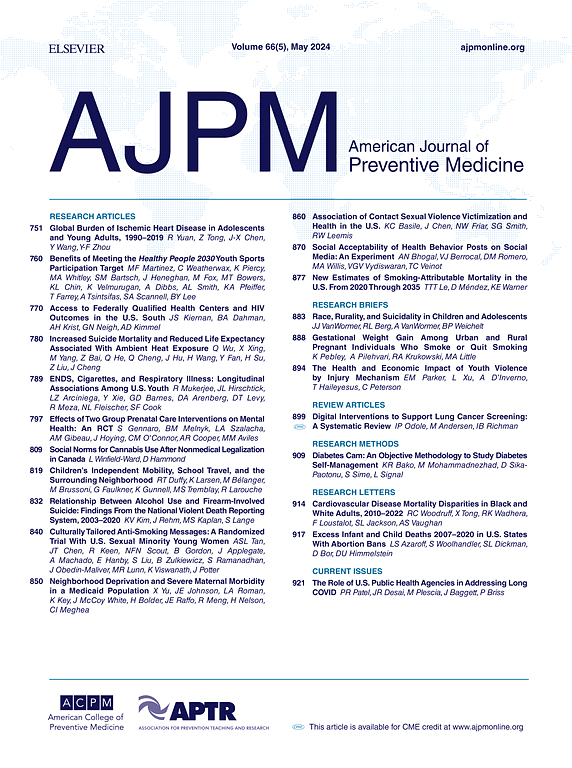Achieving Equitable Lung Cancer Screening Implementation in a Texas Safety Net Health System
IF 4.3
2区 医学
Q1 MEDICINE, GENERAL & INTERNAL
引用次数: 0
Abstract
Introduction
A lung cancer screening program using low dose CT (LDCT) in a Federally Qualified Health Center (FQHC) in Central Texas was developed and assessed for equitable implementation.
Methods
From 11/2020–8/2023, patients aged 55–77 years who currently smoked or quit within 15 years with ≥20 pack-years of exposure were identified through EHR query and mailed outreach, or through direct provider referrals. A bilingual social worker confirmed eligibility, provided telecare shared decision-making (SDM), coordinated screening, and offered smoking cessation. To assess equity, LDCT completion across demographics was compared, in 2023.
Results
A total of 6,486 patients were mailed outreach materials; 479 patients responded, of whom 108 (22.5%) were eligible and 71 (65.7%) participated in SDM. 629 eligible patients were referred internally; 579 (92.0%) completed SDM. Of the 650 patients who completed SDM, 636 (97.8%) agreed to screening. Mean age was 61.7 years; 38.1% were female. The population was diverse: 35.8% identified as Latino, 17.8% as African American, 26.8% had Medicare or Medicaid, 48.0% used the county medical assistance program, 14.2% were uninsured, and 76.7% currently smoked. Overall, 528 (83.0%) patients completed LDCT. There were no statistically significant differences in completion by age, gender, race/ethnicity, or insurance status. Spanish-speaking patients were more likely to complete the CT than English speakers (OR 2.22, 95% CI=1.22, 4.41) and those who formerly smoked were more likely to complete the CT than patients who currently smoked (OR 1.93, 95% CI=1.12, 3.51).
Conclusions
The navigator-centered program achieved equitable implementation of lung cancer screening in a diverse FQHC system.
在得克萨斯州安全网医疗系统中实现公平的肺癌筛查。
简介:德克萨斯州中部一家联邦合格医疗中心(FQHC)制定了一项使用低剂量 CT(LDCT)的肺癌筛查计划,并对其公平实施情况进行了评估:德克萨斯州中部一家联邦合格医疗中心(FQHC)制定了一项使用低剂量 CT(LDCT)的肺癌筛查计划,并对该计划的公平实施情况进行了评估:从 2020 年 11 月至 2023 年 8 月,通过电子病历查询和邮寄宣传材料,或通过医疗服务提供者的直接转介,确定了 55-77 岁、目前吸烟或 15 年内戒烟且吸烟量≥ 20 包年的患者。一名双语社工负责确认资格、提供远程护理共同决策 (SDM)、协调筛查并提供戒烟服务。为了评估公平性,我们对 2023 年不同人口统计学特征的 LDCT 完成情况进行了比较:向 6486 名患者邮寄了宣传材料;479 名患者做出了回复,其中 108 人(22.5%)符合条件,71 人(65.7%)参与了 SDM。629 名符合条件的患者被内部转诊,其中 579 人(92.0%)完成了 SDM。在完成 SDM 的 650 名患者中,有 636 人(97.8%)同意接受筛查。平均年龄为 61.7 岁;38.1% 为女性。人群具有多样性:35.8%为拉丁裔,17.8%为非裔美国人,26.8%有医疗保险或医疗补助计划,48.0%使用县医疗补助计划,14.2%无保险,76.7%目前吸烟。总体而言,528 名患者(83.0%)完成了 LDCT。不同年龄、性别、种族/民族或保险状况的患者在完成率上没有明显的统计学差异。讲西班牙语的患者比讲英语的患者更有可能完成 CT(OR 2.22,95% CI 1.22,4.41),曾经吸烟的患者比目前吸烟的患者更有可能完成 CT(OR 1.93,95% CI 1.12,3.51):以领航员为中心的项目实现了在多样化的家庭健康服务中心系统中公平实施肺癌筛查。
本文章由计算机程序翻译,如有差异,请以英文原文为准。
求助全文
约1分钟内获得全文
求助全文
来源期刊

American Journal of Preventive Medicine
医学-公共卫生、环境卫生与职业卫生
CiteScore
8.60
自引率
1.80%
发文量
395
审稿时长
32 days
期刊介绍:
The American Journal of Preventive Medicine is the official journal of the American College of Preventive Medicine and the Association for Prevention Teaching and Research. It publishes articles in the areas of prevention research, teaching, practice and policy. Original research is published on interventions aimed at the prevention of chronic and acute disease and the promotion of individual and community health.
Of particular emphasis are papers that address the primary and secondary prevention of important clinical, behavioral and public health issues such as injury and violence, infectious disease, women''s health, smoking, sedentary behaviors and physical activity, nutrition, diabetes, obesity, and substance use disorders. Papers also address educational initiatives aimed at improving the ability of health professionals to provide effective clinical prevention and public health services. Papers on health services research pertinent to prevention and public health are also published. The journal also publishes official policy statements from the two co-sponsoring organizations, review articles, media reviews, and editorials. Finally, the journal periodically publishes supplements and special theme issues devoted to areas of current interest to the prevention community.
 求助内容:
求助内容: 应助结果提醒方式:
应助结果提醒方式:


